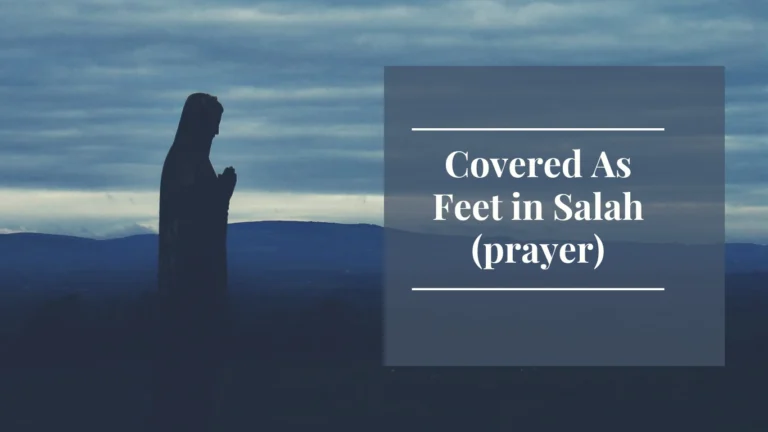For many Muslims, understanding the intricacies of their faith and its practices is a lifelong commitment. One such practice that often sparks debate is the covering of feet during salah (prayer). Is it mandatory? Does it hold any specific significance? This blog will explore these questions and offer insights into the opinions of various scholars to help you better understand this aspect of Islamic practice.
Covered as Feet Meaning
When we talk about “covered as feet,” we’re referring to the idea that certain parts of the body should be covered for modesty’s sake, particularly during prayer. For women, this concept often extends to the feet. But why is this important?
The significance lies in maintaining a state of humility and reverence during prayer. Covering your feet, like other parts of the body, is seen as an act of modesty that aligns with the principles of Islamic decorum.
Covering Feet in Salah Hanafi
The Hanafi school of thought provides specific guidelines on covering the feet during salah. According to Hanafi scholars, women should cover their feet during prayer. The reasoning stems from the belief that the entire body of a woman, except for the face and hands, should be concealed to maintain modesty.
This perspective emphasizes the importance of complete coverage to ensure that one’s focus remains on the spiritual act of praying, devoid of any distractions.
Is Covering Feet Mandatory in Islam?
Is covering the feet a mandatory practice in Islam? The answer varies among scholars and schools of thought. While some consider it obligatory, others view it as highly recommended but not compulsory.
The overarching principle is modesty. Covering your feet is seen as an extension of the broader requirement to dress modestly, especially during acts of worship.
Are Feet Awrah Hanafi?
In the Hanafi school of thought, the term awrah refers to the intimate parts of the body that should be covered. For women, this includes everything except the face, hands, and feet. However, during prayer, it is considered preferable for the feet to be covered.
This indicates a nuanced approach where the feet are not strictly considered awrah but should still be covered during specific religious practices like prayer.
Hadith About Covering Feet in Salah
Several hadiths (traditions of Prophet Muhammad, peace be upon him) speak about the importance of women covering their feet. One notable hadith mentions that women should lower their hems to cover their feet.
This hadith highlights the concern for modesty even in the smallest details, emphasizing the importance of covering the feet during salah.
Is Covering Feet Mandatory in Salah?
For many scholars, covering the feet during salah is seen as mandatory. This belief is rooted in the idea that prayer is a sacred act requiring a heightened state of modesty.
By covering their feet, women fulfill the broader requirement of modesty, ensuring their prayers align with Islamic principles.
Is it Haram to Show Your Feet While Praying?
The term haram means forbidden in Islam. Showing your feet during prayer is not universally considered haram, but many scholars advise against it to maintain modesty.
The focus is on achieving a state of humility and reverence during prayer, which is facilitated by covering the feet.
Is it Haram to Show Your Feet?
Outside of prayer, showing your feet is generally not considered haram. However, the emphasis on modesty remains, and many women choose to cover their feet as part of their overall dress code.
The key is to adhere to the principles of modesty outlined in Islamic teachings, whether during prayer or in everyday life.
Historical Context of Covering Feet
At the time of the Prophet Muhammad (peace be upon him), women were keen to cover themselves completely, including their feet. They would often lower the hems of their garments to ensure full coverage.
This practice reflects the importance placed on modesty and the lengths to which women would go to adhere to these principles.
Scholarly Opinions on Covering Feet
Various scholars have weighed in on the topic of covering feet. Shaykh al-Islam Ibn Taymiyah emphasized that women should wear garments that cover their feet adequately.
Shaykh Ibn ‘Uthaymin echoed this sentiment, stating that covering the feet is prescribed and, according to many scholars, obligatory for women.
Practical Tips for Covering Feet
For those looking to adhere to the practice of covering their feet, there are several practical tips:
- Long Garments: Wearing long skirts or dresses that extend to the ground can ensure your feet are covered.
- Socks: Opt for socks if your garment falls short. Socks provide an easy and effective way to cover your feet.
- Footwear: Choose shoes that cover your feet entirely. This is particularly useful during prayer.
By incorporating these tips, you can ensure that your attire aligns with the principles of modesty emphasized in Islam.
Benefits of Covering Feet
Covering your feet during prayer offers several benefits:
- Enhanced Modesty: It helps maintain a state of modesty, aligning with the principles of Islamic decorum.
- Focus in Prayer: By covering your feet, you minimize distractions, allowing you to focus entirely on your spiritual practice.
- Community Acceptance: Adhering to the practice of covering your feet can also foster a sense of belonging and acceptance within your community.
Conclusion
The act of covering feet in Islam, particularly during salah, holds significant importance. It aligns with the broader principles of modesty and reverence that are central to Islamic teachings. By understanding the perspectives of various scholars and the historical context, we can appreciate the value of this practice.
For those looking to explore this topic further or seeking personalized guidance, consider consulting with knowledgeable scholars or joining community discussions. Your commitment to understanding and adhering to these practices will enrich your spiritual journey and deepen your connection to your faith.

